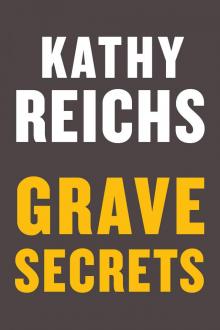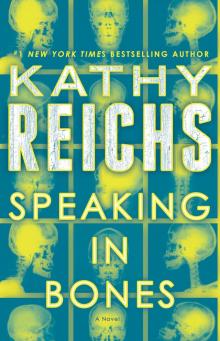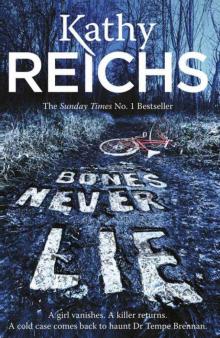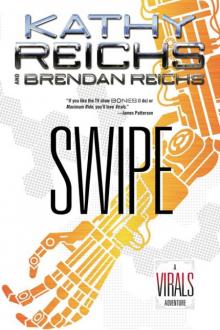- Home
- Kathy Reichs
Spider Bones: A Novel Page 2
Spider Bones: A Novel Read online
Page 2
“Yes, sir.”
Ryan and I watched Bandau lope toward his cruiser.
“Probably DVR’s cop shows,” Ryan said.
“Not the right ones,” I said.
Ryan glanced toward the body, back to me.
“What do you think?”
“Weird one,” I said.
“Suicide? Accident? Murder?”
I spread my palms in a “who knows” gesture.
Ryan smiled. “That’s why I bring you along.”
“The vic probably kept the canoe at the pond and drove the moped back and forth.”
“Back and forth from where?”
“Beats me.”
“Yep. Can’t do without you.”
A wood thrush trilled overhead. Another answered. The cheerful exchange was in stark contrast to the grim conversation below.
As I glanced up, hurried footsteps startled the birds into flight.
“Got him.” Bandau’s aviators were now hanging by one bow from his pocket. “Cold hit in the States. Thirteen-point match.”
Ryan’s brows may have shot higher than mine.
“John Charles Lowery. Date of birth March twenty-first, nineteen fifty.”
“Not bad, Bandau.” This time I said it aloud.
“There’s one problem.”
Bandau’s already deep frown lines deepened.
“John Charles Lowery died in nineteen sixty-eight.”
“HOW’S LOWERY A FLOATER TODAY IF HE CLOCKED OUT FOUR decades back?” Ryan voiced the question I’d been asking myself.
I had no answer.
We were heading north on 15. The coroner’s van was somewhere behind us. Pomerleau and Lauzon would check their soggy passenger into the morgue, where he’d wait in a cooler until I unwrapped him in the morning.
“Maybe the hit was a mistake.”
“Thirteen-point match?” My tone conveyed the skepticism I felt.
“Remember that lawyer in Oregon?”
Brandon Mayfield. The FBI linked him to the Madrid train bombing based on fingerprint evidence. Turned out the match was erroneous.
“That was a fluke,” I said. “You think printing the body on-site will cause blowback?”
“On the good agent, yeah. A bonehead move, but probably little harm done.”
“He meant well.”
Ryan shook his head in disbelief.
For several miles, silence filled the Jeep. Ryan broke it.
“You going home?”
I nodded.
Minutes later we were arcing over the Saint Lawrence on the Champlain Bridge. Below us, the river flowed cold and dark. To one side, tiny gardens and lawns winked nascent green amid the condo and apartment towers on île-des-Soeurs.
Back in the city, traffic moved like mud through a straw. The Jeep lurched and jerked as Ryan shifted between gas and brake.
Kind, yes. Witty, affirmative. Generous, absolutely. Patient, no way. Travel with Ryan was often a trial.
I checked my watch. Five ten.
Normally Ryan would have queried my dining plans by now. Suggested a restaurant. Tonight he didn’t.
Supper with his daughter? Beers with the boys? A date?
Did I care?
I cracked my window. The smell of oily water drifted into the Jeep. Warm cement. Exhaust.
Yeah. I cared.
Would I ask?
No way. Since our breakup we’d established a bimodal new balance. Professional relations: same as always. Social relations: don’t ask, don’t tell.
My choice, really. Though Lutetia was once again history, getting dumped for Ryan’s ex still hurt.
Once burned, twice shy.
And there was Charlie Hunt.
Snapshot image. Charlie on the rooftop deck of his uptown Charlotte brownstone. Cinnamon skin. Emerald eyes. Tall as his daddy, who’d played in the NBA.
Not bad.
I slid a glance toward Ryan.
Sandy hair. Turquoise eyes. Long and lean as his daddy in Nova Scotia.
Not bad either.
Truth be told, after decades of marriage, then a rocky postseparation readjustment, followed by going steady and an undeserved boot to the scrap heap, I was grooving on the nonmonogamy thing.
Except for two teensy details. Ryan hadn’t shared my bed since the previous summer’s split. Charlie Hunt had yet to gain access.
On dual levels it had been a long, cold winter.
The sound of Ryan’s mobile broke into my musings.
I listened as he said a lot of ouis, asked a few questions. From the latter I assumed the call was about John Lowery.
Ryan spoke to me after disconnecting. “Bandau sent a query south. Turns out our boy died in combat in Vietnam.”
“Are you using the Sesame Street theme as your ringtone?”
“Keeping the clouds away,” Ryan sang.
“Got some Big Bird sheets on your bed?”
“Bien sûr, madame.” Big wink. “Want to come check them out?”
“Lowery? Vietnam?”
“Ever hear of an outfit called JPAC?”
“Sure. I used to work with them. The Joint POW/MIA Accounting Command. Used to be called CILHI until two thousand three.”
“Hallelujah. Alphabet soup.”
“Now I’ve said my ABC’s,” I sang.
“Let’s not push the metaphor, Ryan said.
“Central Identification Laboratory Hawaii. JPAC resulted from the merger of CILHI and the Joint Task Force–Full Accounting Commission. JPAC’s lab portion is now referred to as the CIL. It’s the largest forensic anthropology laboratory in the world.”
“Lowery didn’t come through JPAC, but that’s where his case has been bounced. What’s your connection with the place?”
“Every positive JPAC ID has to be approved by a zillion reviewers, some of whom are civilian and external to the CIL. I served in that capacity for many years.”
“Right. I forgot about those midwinter trips to Hawaii.”
“Travel was required twice yearly for lab oversight.”
“And a little surfing, my coconut princess?”
“I don’t surf.”
“How about I hang ten over to your place and we—”
“I rarely had time to set foot on a beach.”
“Uh-huh.”
“When was Lowery ID’ed?” I asked.
“Bandau didn’t say.”
“If it was back in the sixties, things were totally different.”
Ryan turned off rue Sainte-Catherine, drove half a block, and slid to the curb in front of a gray stone complex with elaborate bay windows fronting the sidewalk. Sadly, my unit is in back and derives no benefit from this architectural whimsy.
“You plan to do plastic man first thing tomorrow?”
“Yeah. Since there’s a five-hour time difference, I’ll phone the CIL tonight, see what I can learn about Lowery.”
I felt Ryan’s eyes on my back as I walked toward the door.
Quebec springs usually send a lot of work my way. Rivers and lakes thaw. The snow melts. Corpses emerge. Citizens abandon their sofas for the great outdoors. Some discover the corpses. Some join their ranks.
Because my May rotation to Montreal is usually a long one, Birdie accompanies me as a carry-on under the seat. Except during the flight, the little furball is pretty good company.
The cat was waiting inside the front door.
“Hey, Bird.” I squatted to pet him.
Birdie sniffed my jeans, neck forward, chin up, nose sucking in quick little gulps.
“Good day today?”
Birdie moved off and sat with paws primly together.
“Eau de decomp not your scent?” I rose and tossed my purse onto the sideboard.
Bird raised and licked a paw.
My condo is small. L-shaped living-dining room and shotgun kitchen in front, two bedrooms and two baths in back. It’s located at ground level, in one wing of a four-story U-shaped building. French doors give onto a tiny fen
ced yard from the living room. Opposite, through the dining room, another set opens onto a central courtyard.
Direct access to the lawn on one side and the garden on the other are what hooked me originally. More than a decade down the road, I’m still in the place.
Appetite intact despite the olfactory affront, Birdie padded behind me to the kitchen.
The condo’s interior features earth tones and recycled furniture that I antiqued. Natural wood trim. Stone fireplace. Framed poster of a Jean Dubuffet. Vase full of shells to remind me of the Carolina shore.
My answering machine was blinking like a tripped-out turn signal.
I checked the messages.
My sister, Harry, in Houston, unhappy with her current dating arrangement.
My daughter, Katy, in Charlotte, hating her job, her social life, and the universe in general.
The Gazette, selling subscriptions.
Harry.
My neighbor Sparky complaining about Birdie. Again.
Harry.
Charlie Hunt. “Thinking of you.”
Harry.
Deleting all, I headed for the shower.
Supper was linguini tossed with olive oil, spinach, mushrooms, and feta. Birdie licked the cheese from his pasta, then finished the crunchy brown pellets in his bowl.
After clearing the dishes, I dialed the CIL.
Five thousand miles from the tundra a phone was answered on the first ring. After identifying myself, I asked for Roger Merkel, the lab’s scientific director.
Merkel was in Washington, D.C.
“Dr. Tandler?”
“Hold, please.”
Daniel Tandler is assistant director of the CIL. Being the same age, he and I rose through the forensic ranks together, though always at different institutions. We met as undergrads, via the student association of the American Academy of Forensic Sciences. We’d even enjoyed a brief carnal romp way back at the misty dawn of creation. Good fun, bad timing. Enter Pete Petersons. I married, attended grad school at Northwestern, then joined the faculty first at Northern Illinois University, then at the University of North Carolina at Charlotte. Danny stuck with the University of Tennessee straight through, and upon completion of his doctorate, beelined to Hawaii.
The one that got away? Maybe. But, alas, too bad. Danny Tandler is now married and out of play.
Over the years Danny and I have provided mutual support through dissertation defenses, board exams, job interviews, and promotion reviews. When the CIL needed a new external consultant, Danny proposed my name. That was back in the early nineties. I served in that capacity for almost ten years.
The wait for Tandler was a wee bit longer than the one for the initial switchboard pickup.
“Tempe, me lass. How’s it hanging?” A voice hinting of country and wide-open spaces.
“Good.”
“Tell me you’ve reconsidered and are coming back on board.”
“Not yet.”
“It’s eighty degrees right now. Wait, wait.” Dramatic rustling. “OK. Got my shades on. The sun off the water was blinding my vision.”
“You’re inside a building on a military base.”
“Palm fronds are gently kissing my window.”
“Save it for winter. It’s beautiful here now.”
“To what do I owe this unexpected surprise?”
I told him about the pond, the plastic, and the fingerprint identification of the victim as Lowery.
“Why the packaging?”
“No idea.”
“Bizarre. Let me see if I can pull Lowery’s file.”
It took a full ten minutes.
“Sorry. We’ve got an arrival ceremony starting in less than an hour. Most folks have already headed over to the hangar. For now I can give you the basics. Details will have to wait.”
“I understand.”
I did. An arrival ceremony is a solemn occasion honoring an unknown soldier, sailor, airman, or marine fallen far from home in the line of duty. Following recovery and transfer to U.S. soil, it is step one in the complicated path to repatriation.
I’d attended several arrival ceremonies during my tenure with JPAC. I envisioned the scene about to play out. The newly arrived aircraft. The servicemen and women standing at attention. The flag-draped transfer container. The solemn cross-base drive to the CIL lab.
“Private John Charles Lowery was an eighteen-year-old white male. Went in-country on June twenty-fourth, nineteen sixty-seven.” Danny’s tone suggested he was skimming, picking out relevant facts. “Lowery went down in a Huey near Long Binh on January twenty-third, nineteen sixty-eight.” Pause. “Body was recovered several days later, ID’ed, returned to family for burial.”
“Burial where?”
“Your neck o’ the woods. Lumberton, North Carolina.”
“You’re kidding.”
I heard a voice in the background. Danny said something. The voice responded.
“Sorry, Tempe. I’ve got to go.”
“No problem. I’ll talk to you tomorrow. I should know more once I’ve examined our guy.”
That’s not how it went.
THE NEXT DAY I ROSE AT SEVEN. THIRTY MINUTES LATER I WAS worming my Mazda through the Ville-Marie Tunnel. Again, the weather was splendid.
The Édifice Wilfrid-Derome is a looming T-shaped thirteen-story structure in the Hochelaga-Maisonneuve district east of centre-ville. The Laboratoire de sciences judiciaires et de médecine légale occupies the building’s top two floors. The Bureau du coroner is on eleven, the morgue is in the basement. The remaining acreage belongs to the SQ.
Yesiree. Ryan and I work just eight floors apart.
Though the morning staff meeting held no unpleasant surprise for the anthropologist, it had been an unusually busy Thursday. A workplace electrocution and a stabbing went to one pathologist. A suspicious crib death and a fire victim went to another. Pierre LaManche, director of the LSJML’s medico-legal section, assigned himself an apparent suicide involving a teenage boy.
LaManche also assumed responsibility for LSJML-49744, the case number assigned to John Lowery, but asked that I get the ball rolling. Since ID had been established via prints, once preliminaries were done, depending on body condition, either LaManche would perform a normal autopsy, or I would clean the bones and do a skeletal analysis.
By nine thirty I was downstairs in salle d’autopsie number 4, a unit specially outfitted for decomps, floaters, and other aromatics. I work there a lot.
Like its three counterparts, salle 4 has swinging doors leading to parallel morgue bays divided into refrigerated compartments. Small white cards mark the presence of temporary residents.
After locating the bay in which LSJML-49744 waited, I got the Nikon and checked its battery. Then I pulled the stainless steel handle.
The smell of putrefying flesh rode the whoosh of refrigerated air. Disengaging the foot brake, I pulled the gurney from its slot.
Pomerleau and Lauzon had dispensed with the usual body bag. Understandable, given Lowery’s exotic outerwear.
I was shooting wide views when a door clicked open and footsteps squeaked across tile.
Seconds later Lisa Savard appeared.
Honey blond, with a ready smile and Dolly Parton jugs, Lisa is the darling of every straight homicide cop in Quebec. She’s my favorite, too, for different reasons. The woman is the best autopsy tech in the province.
Wanting to improve her fluency, Lisa always speaks English to me.
“A strange one, yes?”
“Definitely.”
Lisa studied Lowery a moment.
“Looks like a Ken doll still in the package. Radiology?”
“Yes, please.”
While Lisa shot X-rays, I went through Lowery’s dossier. So far it held little. The police incident sheet. The morgue intake form. Bandau’s report of the NCIC hit. A fax showing an ancient fingerprint card.
I checked the source of the fax. NCIC.
Curious. If Lowery died in ’68, wh
y was he in the system? Were prints that old typically entered?
On impulse, I called the fingerprint section of Service de l’identité judiciaire. A Sergeant Boniface told me to come on up. Grabbing the file, I climbed the back stairs to the first floor.
* * *
Forty minutes later I descended, knowing a dizzying amount about tented arches, ulnar loops, and accidental whorls. Bottom line: though Boniface was uncertain why Lowery was in the FBI database, he had no doubt the match was legit.
Lowery now lay on a floor-bolted table in the center of salle 4. Flies crawled his plastic shroud and buzzed the air above it. A police photographer shot overviews from a ladder.
LaManche and Lisa were examining X-rays popped onto wall-mounted light boxes. I joined them as they moved along the row.
On each film, the skeleton glowed white within the pale gray of the flesh. I noted nothing unusual in the skull or bones.
We were on the fifth plate when LaManche’s gnarled finger tapped an object lying by Lowery’s right foot. Radiopaque, the thing lay angled across the calcaneous.
“Un couteau,” Lisa said. A knife.
“Oui,” LaManche said.
I agreed.
The next prize appeared in a view of the thorax. Roughly eight centimeters long and two centimeters wide, the second object glowed as bright as the first.
“Mais oui.” LaManche nodded slowly, finally understanding. “Oui.” The nodding morphed to head shaking. “Sacrebleu.”
Great. The bizarre death now made sense to the chief. I still didn’t get it.
I considered the shape on Lowery’s chest. It wasn’t another knife. Nor was it a watch, a belt buckle, or a piece of fishing paraphernalia. I hadn’t a clue.
Crossing to the body, LaManche began dictating notes.
“Victim is enclosed in what appears to be a homemade bag constructed of a large plastic sheet doubled over and secured with duct tape. The bottom and all but the top ten centimeters of one side are sealed from the outside. The neck end and top ten centimeters of the side are sealed from the inside.
“The plastic has been freshly cut, exposing the right hand. Moderate insect activity is evident in the region of the cut.”
As LaManche droned on with details, the photographer snapped away, repositioning the case identifier with each shot.
“It appears the victim entered the bag, then secured the plastic using one arm extended through the ten-centimeter side opening, which was later sealed from the inside.”

 Two Nights
Two Nights The Bone Collection: Four Novellas
The Bone Collection: Four Novellas Fatal Voyage
Fatal Voyage 206 Bones
206 Bones Bones to Ashes
Bones to Ashes Terminal
Terminal Monday Mourning
Monday Mourning Flash and Bones
Flash and Bones Cross Bones
Cross Bones Devil Bones
Devil Bones Break No Bones
Break No Bones Swamp Bones
Swamp Bones Déjà Dead
Déjà Dead Shock
Shock Spider Bones
Spider Bones Death Du Jour
Death Du Jour Grave Secrets
Grave Secrets Trace Evidence: A Virals Short Story Collection
Trace Evidence: A Virals Short Story Collection Bones on Ice
Bones on Ice The Bone Code
The Bone Code Bones in Her Pocket
Bones in Her Pocket Seizure:
Seizure: Speaking in Bones
Speaking in Bones Deadly Decisions
Deadly Decisions Spike
Spike Bones Never Lie
Bones Never Lie Bones of the Lost
Bones of the Lost Virals 03.5 - Swipe
Virals 03.5 - Swipe Exposure
Exposure A Conspiracy of Bones
A Conspiracy of Bones Shift (tory brennan)
Shift (tory brennan) Bones of the Lost: A Temperance Brennan Novel tb-16
Bones of the Lost: A Temperance Brennan Novel tb-16 Virals tb-1
Virals tb-1 Bones Are Forever tb-15
Bones Are Forever tb-15 Code tb-3
Code tb-3 Seizure tb-2
Seizure tb-2 Deadly Descisions
Deadly Descisions Spider Bones: A Novel
Spider Bones: A Novel